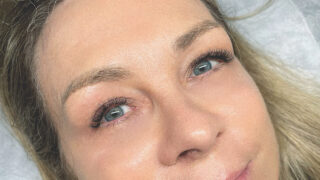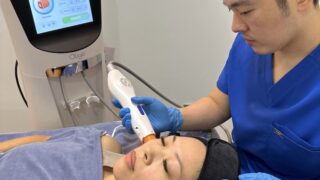You’ve probably heard the buzz around semaglutide and tirzepatide – medications originally developed to treat type 2 diabetes. What you may not have heard of is “Ozempic face”, a potential side effect where cheeks appear sunken and hollow after rapid weight loss, explains Dr Bernard Tan, Medical Director and Founder of Bay Aesthetics Clinic. Here, he dives into why it happens, plus a few other side effects of these drugs.
But first – what are these medications?
“Semaglutide belongs to a category of medications called GLP-1 receptor agonists. Semaglutide works by targeting GLP-1 receptors in your brain, the same ones that control hunger and fullness,” explains Dr Tan. Semaglutide is taken as a weekly injection – usually in the abdomen, thigh or upper arm.

Meanwhile, a higher-dose version of the semaglutide injection is approved in Singapore for weight management. It is administered weekly and works best with a healthy lifestyle.
The ingredient tirzepatide works a bit differently. “Tirzepatide is a dual-action hormone that targets both GLP-1 and GIP receptors. It is also administered as a weekly injection.”
Dr Tan tells us that due to a worldwide shortage, stocks of some of these drugs are not yet available in Singapore, with supply expected to become available in 2026.
What exactly is ‘Ozempic face’?
“Ozempic face refers to the excessively skinny, gaunt and aged look often seen in individuals who have recently undergone rapid weight loss. Think a hollow and sunken appearance on the cheeks and temples, accelerated signs of ageing such as loose skin and wrinkles, deeper nasolabial folds (laugh lines), marionette lines and jowls, and more prominent sagging skin around the jawline and neck.”
Dr Tan highlights several risk factors that have been identified in the development of Ozempic face:
- The amount of weight loss. Individuals who experience significant weight loss, defined as over 10 percent of their body weight, are more likely to develop Ozempic face.
- The speed of weight loss. Those who lose too much too quickly (e.g., rapid weight loss within a period of less than six months) are at higher risk. This is because facial fat reduces rapidly, without giving the skin enough time to catch up.
- Age. Individuals in their 40s and 50s, who already have notable collagen loss, are more likely to develop Ozempic face as their skin no longer has the elasticity to “bounce back”.
Thankfully, this sunken appearance can be addressed with a variety of treatments to help restore lost volume. Dr Tan suggests that patients who develop Ozempic face may consider non-invasive treatments such as Ultherapy Prime, Oligio monopolar RF or collagen stimulating injections to tighten and lift the skin.
Other side effects besides Ozempic face
Ozempic face may be one of the most noticeable side effects, but it’s not the only one. Dr Tan highlights a few other side effects and risks associated with medications with the ingredients semaglutide and tirzepatide:
- Gastrointestinal issues. Nausea, vomiting, diarrhoea, reflux and constipation affect 10 to 20 percent of users. These are due to the activation of GLP-1 receptors in the gut. Symptoms are usually mild and resolve within three to four weeks.
- Neurological side effects. Headaches, dizziness and fatigue can also occur in about 10 to 20 percent of patients. These are usually mild and resolve within three to four weeks as your body adjusts to the medication.
- Hepatobiliary risks. Gallstone formation and acute pancreatitis are rare but potentially severe adverse effects. The risk of developing pancreatitis was estimated at 0.2 to 0.5 percent during clinical trials.
- Pregnancy or breastfeeding risks. These medications are not recommended during pregnancy or lactation. Women of childbearing potential are recommended to use contraception with taking these medications.
Is there any way to minimise or avoid these side effects?
“Only medical doctors experienced in weight management and diabetes treatment should prescribe these medications with semaglutide and tirzepatide, with close supervision and regular monitoring,” emphasises Dr Tan. “The key is to start at a lower dosage, gradually increasing after four to six weeks. This gives the body time to acclimatise and helps reduce common side effects like nausea, vomiting and diarrhoea. Before starting the medication, patients should undergo a detailed medical consultation to ensure no contraindications.”
At Bay Aesthetics Clinic, Dr Tan and his fellow Medical Director Dr Hoe Ying Min have over 20 years of combined experience and have treated thousands of patients with successful outcomes. Their treatment philosophy focuses on natural-looking results and takes a holistic approach to patient wellness and health. Contact them to schedule a medical consultation and learn more.
Bay Aesthetics Clinic is at #B2-12 Marina Bay Link Mall, 8A Marina Boulevard.
8428 7811 | bayclinic.sg
Liked this article about Ozempic face and other side effects of medications like semaglutide and tirzepatide? Check out our Hair & Beauty page for more features!
Don't miss out on the latest events, news and
competitions by signing up to our newsletter!
By signing up, you'll receive our weekly newsletter and offers which you can update or unsubscribe to anytime.





